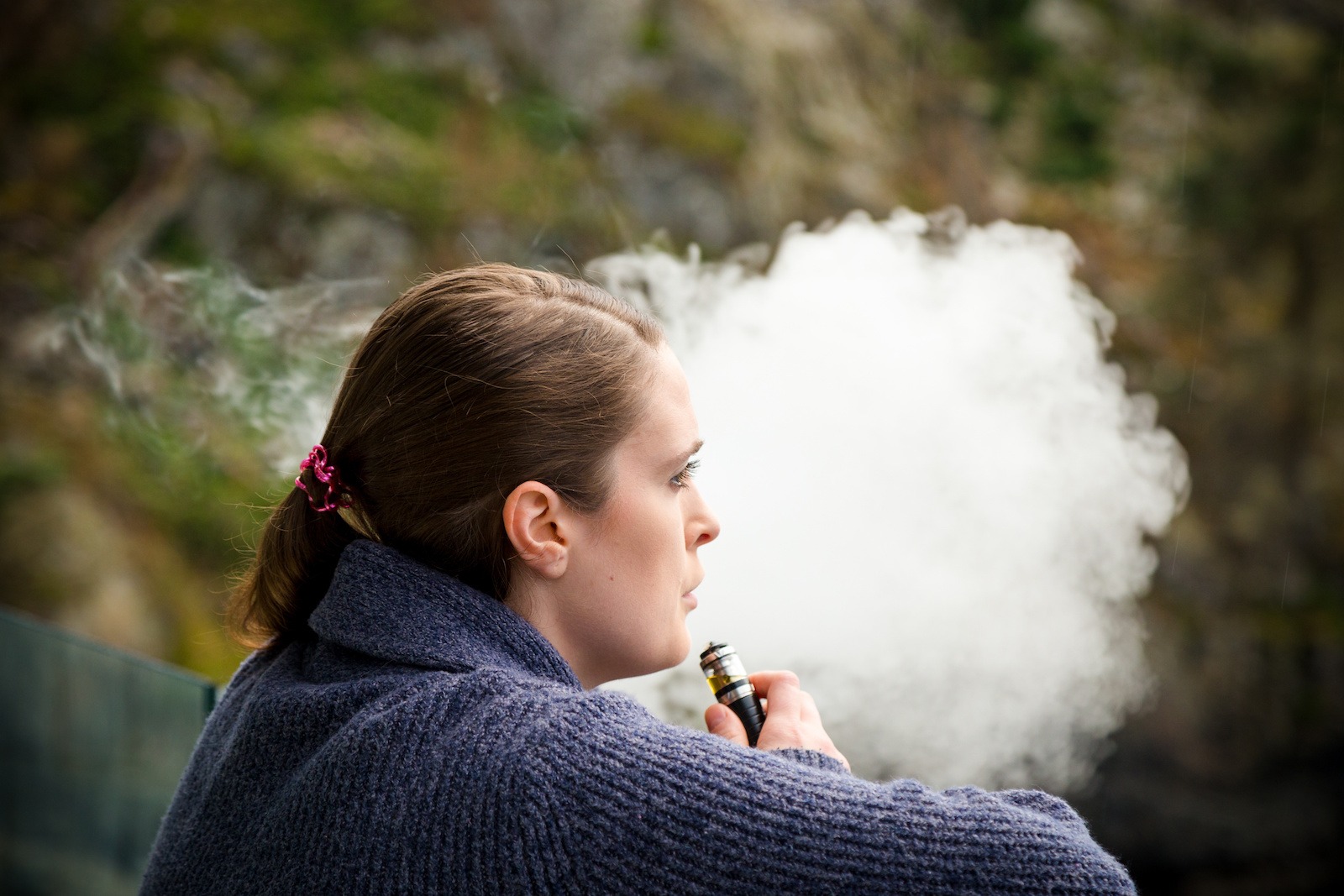Substances | 5 min read
Are No Nicotine Vapes Safe To Use? Side-Effects & Risks of Using A Nicotine Free Vape
Medically Reviewed By

On August 21, 2024
Written By
On March 27, 2022

What you will learn
- No-nicotine vapes are electronic devices that vaporize fluid for inhalation without nicotine.
- Nicotine-free vapes are often seen as a safer alternative to nicotine vapes or tobacco products, but they still have side effects and risks.
- Some products labeled as nicotine-free vapes have been found to contain nicotine.
- Vaping is a growing problem among teens, leading to addiction and health concerns.
Nicotine-free vapes, or no-nicotine vapes, are electronic devices that vaporize fluid for inhalation without the presence of nicotine. Though they may seem like a safer alternative to nicotine products, they’re not without side effects and risks.
Learn more about no-nicotine vapes, how they’re used, the side effects and risks, and what you need to consider before using them.
What Is a No-Nicotine Vape?
A no-nicotine vape is a rechargeable electronic cigarette (e-cigarette), disposable vape, or vaping device that operates similarly to vapes with nicotine but uses e-liquids that do not contain nicotine. These devices are often used to enjoy the sensory experience of vaping without the addictive properties of nicotine or conventional tobacco products.
What Is in No-Nicotine Vapes?
The contents of zero nicotine vapes vary, but they generally contain:
- Base liquids: A mixture of propylene glycol (PG) and vegetable glycerin (VG) that create a vapor when heated.
- Flavorings: Various food-grade flavorings provide different tastes, from fruits to desserts to conventional tobacco flavors.
- Optional additives: Some e-liquids may contain additives like water or small amounts of alcohol to adjust viscosity or enhance flavor.
- While these ingredients are considered safe for ingestion, the long-term effects of inhaling them as a vapor is still being researched.
Do no-nicotine Vapes Contain Any Nicotine?
There’s a question of whether no-nicotine vapes are truly nicotine free. Some studies and investigations have found traces of nicotine in products labeled as nicotine-free. An investigative report from The Guardian discovered that vapes sold on Amazon as “nicotine-free” have been found to contain the substance.[1]
Of the seven vapes tested, six were found to have some amount of nicotine.[2] Some even had nicotine levels that exceeded the legal limit of 2ml in the UK. Though the products have since been removed pending further investigation, other nicotine-free vapes can contain trace amounts of nicotine or higher, exposing people to unknown health risks.
The Epidemic of Teen Vaping
E-cigarettes are among the most commonly used tobacco products in teens.[3] Nicotine can harm the parts of a teen’s brain that control attention, learning, mood, and impulse control.[4] Even no-nicotine vapes may contain trace amounts of nicotine that can pose health risks.
E-cigarette marketing, the variety of flavored e-juice like watermelon and blue raspberry, social influences, and the effects of nicotine can encourage teens to start or continue vaping, just like smoking cigarettes.[5] However, the influence may be worse because vaping is regarded as a safer alternative to tobacco products – especially with no-nicotine vapes.
Is a Vape Without Nicotine Safe?
Though no-nicotine vapes don’t contain the addictive substance, there are other risks to consider:
Mouth and Airway Irritation
When heated, the components of vape juice may irritate the mouth and airways. According to one study in 2015, one puff from a nicotine-free shisha pen contained enough propylene glycol and glycerol, two common base liquids, to cause mouth and throat irritation.[6]
When vaporized, these substances may have the potential to form carcinogenic (cancer-causing) compounds.
Inflammation
Nicotine-free vaping may trigger an immune response in the body. Based on a 2018 in-vitro study, exposure can cause an inflammatory response in the body’s immune system cells, typically in the lungs and throat.[7] Heavy use of vapes can cause an inflammatory response throughout the body.
Another in-vitro study concluded that exposure to the juice flavoring compounds in vapes activates the inflammatory response in certain white blood cells that can affect the immune system.[8]
Cell Toxicity
Nicotine-free e-cigarette liquid may be toxic to cells. Research shows that exposure to e-cigarette vapors leads to cell death even without nicotine.[9] The affected cells are found in the lungs and are meant to defend the body against infectious particles, allergens, and other contaminants in the air you breathe.
Another study found that exposure to flavoring additives in e-cigarettes can harm endothelial cells in blood vessels[10], impacting long-term heart health. The death of these cells may contribute to vascular conditions like diabetes, heart disease, and high blood pressure.
Pregnancy Risks
It’s well known that smoking during pregnancy is harmful to pregnant women and their babies. While research suggests that vaping is a less harmful alternative to smoking cigarettes during pregnancy, it’s still not considered safe.
Most e-cigarettes contain nicotine, which can permanently damage a baby’s developing brain and other organs.[11] There are also risks with the chemicals in the flavors and other additives that may negatively affect the pregnant mother or developing baby.
Chemical Side Effects
While many vape fluid flavors are safe for consumption and considered safe, some are associated with harmful side effects. One study found in 51 different vape juice flavors, diacetyl, acetylpropionyl, and acetoin were present in 92% of the flavors tested.[12] 39 of the 51 flavors tested contained a concentration of diacetyl that exceeded the laboratory limit. Diacetyl is used in buttery or creamy food flavors but inhaled, it can cause serious respiratory illnesses.
Some other chemicals have been associated with adverse health effects. Researchers found that cinnamaldehyde, a cinnamon flavor, had significant toxic effects on white blood cells. O-vanillin, a vanilla flavor, and pentanedione, a honey flavor, have caused cellular toxicity.
The FDA regulates vaping products and requires a warning for nicotine but not potentially harmful flavorings. If you vape, you can avoid some of the harmful chemicals that are associated with specific flavors, including:
- Almond
- Bread
- Burnt
- Berry
- Camphor
- Caramel
- Chocolate
- Cinnamon
- Clove
- Coffee
- Cotton candy
- Creamy
- Fruity
- Herbal
- Jam
- Nutty
- Pineapple
- Powdery
- Red hot
- Spicy
- Sweet
- Thyme
- Tomato
- Tropical
- Vanilla
No-Nicotine vs. Nicotine Vaping
There’s plenty of research into the risks of nicotine, but they focus primarily on the effects of smoking tobacco. Nicotine has been found to increase the risk of respiratory, heart, and digestive illnesses and has been associated with a weakened immune system and poor reproductive health. Nicotine is also addictive and has carcinogenic properties.
Is no-nicotine vaping healthier? The research is limited, but some studies have compared the effects of nicotine-free vaping vs. vaping with nicotine. One study of 20 participants compared the 24-hour effects of no-nicotine vaping in participants who smoked cigarettes and those who didn’t.
The study showed that the participants who used no-nicotine vapes had no immediate adverse effects after short-term use in people who didn’t smoke. In people who did smoke, there was a small effect on lung function.[13]
Another study from 2018 showed that vaping fluids with nicotine caused a significant increase in blood pressure that lasted 45 seconds after vaping.
Vaping vs. Smoking
Is vaping better than smoking cigarettes, with or without nicotine? Cigarette smoking is the number one cause of preventable deaths in the US. Vaping is often used as a method to quit cigarettes and may be associated with fewer health risks, but it’s not without risks completely.
If you don’t currently smoke cigarettes or use tobacco products, vaping may increase your risk of adverse effects.
Get Help If You’re Addicted to Vaping
Whether a vape contains nicotine or not, it’s possible to become addicted to the experience of vaping. Vaping comes with many possible side effects and risks, many of which we may not even know at this time. If you’re struggling with addiction to vaping, it’s important to seek treatment and get on a healthier path, free from nicotine and vaping.
Frequently Asked Questions About No-Nicotine Vape
No, nicotine-free vapes that have no nicotine will not be addictive. Nicotine is the addictive substance that makes cigarettes and nicotine vapes habit-forming. However, you can develop a process addiction to the experience of vaping rather than the substances themselves.
While it may be less harmful than smoking tobacco, vaping without nicotine still involves inhaling potentially dangerous chemicals and flavorings. The long-term effects of vaping are still being investigated.
Some people prefer no-nicotine vapes as an alternative to nicotine vaping or smoking cigarettes. They may use them to get the sensory experience of smoking or enjoy the flavored vapor without worrying about becoming addicted.
Vaping is often used as a tool to help with smoking cessation, as it can help you wean off of nicotine and combat cravings. However, some people may replace smoking cigarettes with vaping, so they’re not addressing the underlying addiction. Quitting entirely is the best approach for your health.
Ascendant New York Editorial Guidelines
Here at Ascendant New York, we understand the importance of having access to accurate medical information you can trust, especially when you or a loved one is suffering from addiction. Find out more on our policy.
[1,2] Guardian News and Media. (2023, September 23). “nicotine-free” vapes sold on Amazon found to contain nicotine. The Guardian. Retrieved from https://www.theguardian.com/society/2023/sep/23/nicotine-free-vapes-sold-on-amazon-found-to-contain-nicotine on 2024, July 24.
[3,4,5] Centers for Disease Control and Prevention. (n.d.). E-cigarette use among youth. Centers for Disease Control and Prevention. Retrieved from https://www.cdc.gov/tobacco/e-cigarettes/youth.html on 2024, July 24.
[6] Kienhuis, A. S., Soeteman-Hernandez, L. G., Bos, P. M., Cremers, H. W., Klerx, W. N., & Talhout, R. (2015, June 27). Potential harmful health effects of inhaling nicotine-free shisha-pen vapor: A chemical risk assessment of the main components propylene glycol and glycerol – tobacco induced diseases. BioMed Central. Retrieved from https://tobaccoinduceddiseases.biomedcentral.com/articles/10.1186/s12971-015-0038-7 on 2024, July 24.
[7] Scott, A., Lugg, S. T., Aldridge, K., Lewis, K. E., Bowden, A., Mahida, R. Y., Grudzinska, F. S., Dosanjh, D., Parekh, D., Foronjy, R., Sapey, E., Naidu, B., & Thickett, D. R. (2018, December 1). Pro-inflammatory effects of e-cigarette vapour condensate on human alveolar macrophages. Thorax. Retrieved from https://thorax.bmj.com/content/73/12/1161 on 2024, July 24.
[8,9] Muthumalage, T., Prinz, M., Ansah, K. O., Gerloff, J., Sundar, I. K., & Rahman, I. (2017, December 21). Inflammatory and oxidative responses induced by exposure to commonly used e-cigarette flavoring chemicals and flavored e-liquids without nicotine. Frontiers. Retrieved from https://www.frontiersin.org/articles/10.3389/fphys.2017.01130/ on 2024, July 24.
[10] Ahajournals. (n.d.-a). Retrieved from https://www.ahajournals.org/doi/pdf/10.1161/ATVBAHA.118.311145 on 2024, July 24.
[11] Mayo Foundation for Medical Education and Research. (2023a, March 24). Vaping during pregnancy: Is it safe?. Mayo Clinic. Retrieved from https://www.mayoclinic.org/healthy-lifestyle/pregnancy-week-by-week/expert-answers/vaping-during-pregnancy/faq-20462062. on 2024, July 24.
[12] Allen, J. G., Flanigan, S. S., LeBlanc, M., Vallarino, J., MacNaughton, P., Stewart, J. H., & Christiani, D. C. (2016, June). Flavoring chemicals in e-cigarettes: Diacetyl, 2,3-pentanedione, and acetoin in a sample of 51 products, including fruit-, candy-, and cocktail-flavored e-cigarettes. Environmental health perspectives. Retrieved from https://www.ncbi.nlm.nih.gov/pubmed/26642857 on 2024, July 24.
[13] Ferrari, M., Zanasi, A., Nardi, E., Morselli Labate, A. M., Ceriana, P., Balestrino, A., Pisani, L., Corcione, N., & Nava, S. (2015, October 12). Short-term effects of a nicotine-free e-cigarette compared to a traditional cigarette in smokers and non-smokers. BMC pulmonary medicine. Retrieved from https://www.ncbi.nlm.nih.gov/pmc/articles/PMC4603923/ on 2024, July 24.





